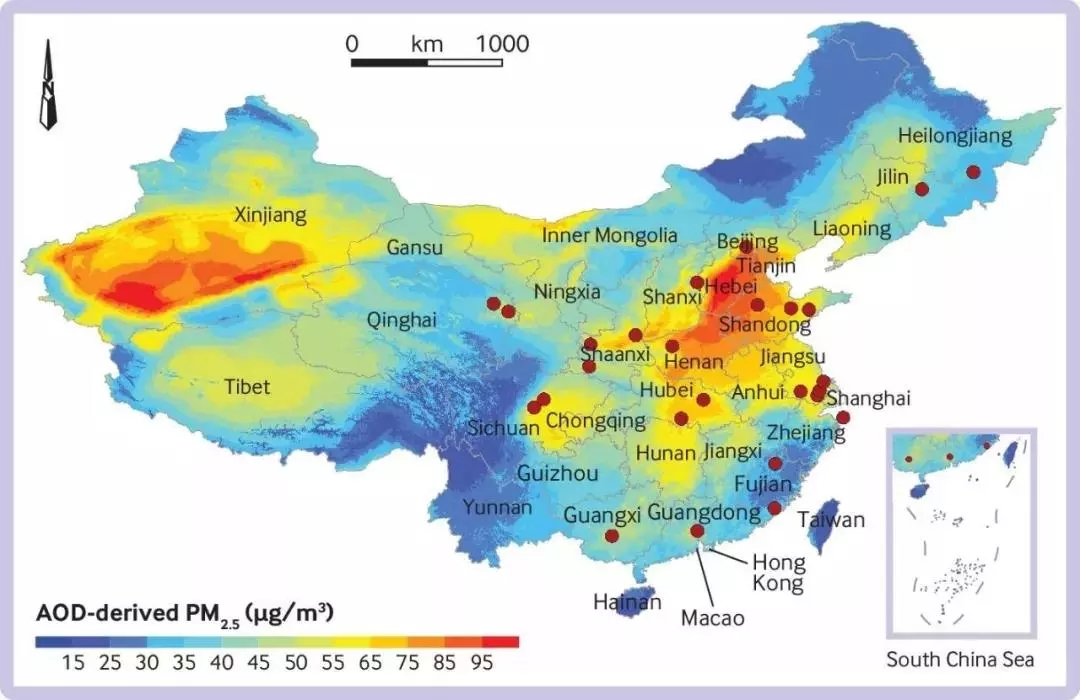Detail
Air pollution Of the 522 cities monitored in 2005, 11% were considered heavily polluted and only 56% had air quality that met the State Environmental Protection Administration of China (SEPA) standard . The major air pollutants are particulate matter (PM), SO2, and nitrogen oxides (NOx). Currently, >40% of China’s cities are suffering from high levels of suspended particles (total concentrations of suspended particles >200 μg/m3, or PM10 >100 μg/m3) . Ozone has recently aroused much attention because of its harmful impacts on agricultural production and human health. A study in Shanghai revealed that ozone levels are associated significantly with total and cardiovascular mortality, especially during cold seasons . High concentrations of ozone have caused crop losses in many regions of China. However, large uncertainty still exists in how to scale surface ozone distribution and crop impacts up to the national level, because of highly inadequate monitoring facilities .

Causes
Ozone has recently aroused much attention because of its harmful impacts on agricultural production and human health. A study in Shanghai revealed that ozone levels are associated significantly with total and cardiovascular mortality, especially during cold seasons . High concentrations of ozone have caused crop losses in many regions of China. However, large uncertainty still exists in how to scale surface ozone distribution and crop impacts up to the national level, because of highly inadequate monitoring facilities .
The main causes, characteristics, and future trends of air pollution in China are related to the energy sector as well as to industrial development, traffic, and urbanization. An estimated 70% of total smoke (aerosols), 90% of SO2, and 67% of NOx are released by burning coal . Meanwhile, the number of motor vehicles in China reached 36 million in 2003, compared with 6.2 million in 1990 . Thus, the ever-increasing number of vehicles has become an important contributor to the increasing air pollution.

The energy infrastructure in China is not expected to change in the near future, and coal will remain the dominant energy source for at least the next several years. In addition, vehicle exhaust and urban activities will increase rapidly in the coming years. Therefore, the emissions of aerosols, SO2, and NOx are expected to continue to increase. For that reason, energy efficiency must be improved, and effective measures are needed to prevent further deterioration of air quality.
Consequences
The impacts of the aforementioned environmental problem are significant and multifaceted. They include damage to human health, social conflicts, and economic losses.
Acid rain resulting from air pollution is prevalent in southern China. Chemically, the major anion in acid rain is SO4 2–, but recently the concentration of NO3 – has increased, which shows that the contribution of NOx is increasing. Acid rain leads to acidification of surface waters and soils, which can cause ecosystem dysfunction, including loss of fish populations and forest dieback . In 2005, ~38% of Chinese cities and counties had annual average pH values <5.6. This indicates that they were likely affected by acid rain. The deposition of sulfur in some places is higher than what was reported from the Black Triangle in central Europe in the early 1980s.

Approximately 60% of China’s population is rural, and nearly all rural residents use highly polluting biomass and coal for household cooking and heating. Indoor air pollution from use of solid fuel in China is responsible for ~420,000 premature deaths annually. In 2002, China introduced an indoor air quality standard , in which the maximum level of PM10 was set at 150 μg/m3. Although the standard is high compared with the World Health Organization guideline of 50 μg/m3, indoor air pollution is expected to improve with the implementation of the standard.
Contaminated soil and water affect human health mainly through the food chain. In China, E-waste recycling sites, such as this one in the town of Taizhou, Zhejiang Province, have become a major source of pollution in certain regions of China. QINGHUA ZHANG November 15, 2007 / Environmental Science & Technology n 7599 ~7.3% of arable land is irrigated with sewage water, of which 20% has been polluted with heavy metals, such as Cd, As, Cr, and Pb. Symptoms of arsenic poisoning from upstream mining activities have emerged among the ~180,000 local inhabitants of seven counties within 6100 km2 in Hetao Area. The long-term mercury mining in Guizhou Province, southwestern China, has resulted in significant pollution of the local ecosystem. The concentrations of total mercury (THg) in rice grains from one mining area have reached 0.57 mg/kg. The SEPA tolerance limit for THg in foodstuffs is 0.02 mg/kg.
Environmental deterioration, which resulted in ~51,000 disputes in 2005, has been considered one of the important causes of social unrest in Chinese society. The total economic losses from environmental pollution and ecological damage were estimated to be 7–20% of the annual GDP during the past 20 years.